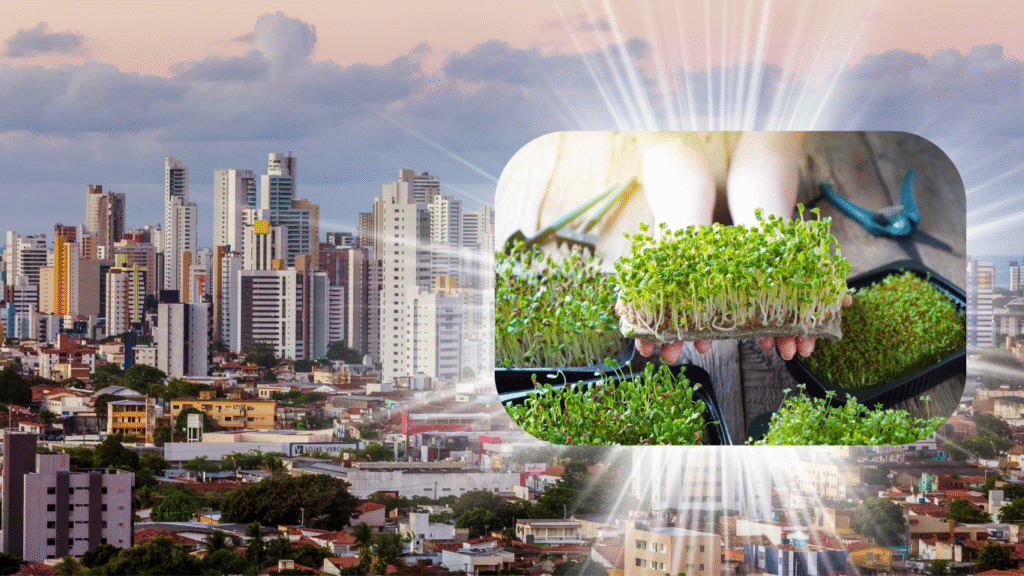Microgreens and urban agriculture II

In the previous article, we explored the incorporation of microgreens into urban agriculture1. In this article, we will continue analyzing different aspects of their integration into this type of farming: how to develop vertical gardens, how to implement them as a business, the emerging future of urban agriculture, and, of course, the challenges and drawbacks that come with it, but which can be overcome.
Ready? Let’s get to it!
Vertical gardens
First, if we look up the definition of vertical farming, we find that it is the cultivation of plants in vertically stacked layers, usually indoors, such as in buildings or warehouses.
It is characterized by the use of artificial lighting (such as LED lights), controlled temperature, humidity, and nutrients, as well as soilless techniques like hydroponics or aeroponics. This allows for producing more food in less space and more efficiently, even in urban environments.
The most important concept here is the idea of growing more with less space. Instead of depending on soil and climate, plants develop in digitally controlled environments, with precisely adjusted temperature, humidity, and nutrient levels.
Hydroponics and aeroponics, described in recent studies by the Food and Agriculture Organization of the United Nations and The Journal of Horticultural Science and Biotechnology, allow cultivation without soil and optimize water use.
Companies like iFarm and Eden Green have taken this model to the next level. Using IoT (Internet of Things) sensors, crop management software, and adjustable lighting systems, they control every environmental variable in real time. An algorithm decides when to water, how many nutrients to apply, and what light intensity is most suitable.
In this way, biology and engineering merge to maximize yield. Microgreens, with their short life cycle, fit perfectly into these cultivation systems.
As a business
All these advantages, the possibility of planting with few economic resources, in small spaces, and with minimal maintenance, have led to the rise of local microenterprises, neighborhood cooperatives, and self sufficient restaurants that grow their own fresh microgreens.
For example, some start ups already grow microgreens in former warehouse spaces and distribute them directly to downtown restaurants without intermediaries. Other similar projects use digital platforms to optimize production and sales based on demand.
There are also cases in which urban producers rent technology or cultivation space, without the need to own infrastructure.
The result is a network of small urban farmers who use technology to optimize production. This type of agriculture reduces pollution from transportation, minimizes food waste, and eliminates intermediaries and much of the distribution chain of large corporations.
Of course, adopting these models requires education, regulation, and equitable access to technology.
The reality is…
Although vertical farming is presented as a sustainable solution, its current implementation is far from perfect. The energy costs associated with lighting and climate control remain high. A study published by The Journal of Horticultural Science and Biotechnology estimates that the electricity consumption of a vertical installation can exceed 300 kWh per square meter per year, depending on the type of LED lighting used.
Moreover, many systems use single-use plastic trays, generating waste that is difficult to recycle. Even the nutrients used often come from unsustainable processes.
The key, then, lies in moving toward truly circular systems:
• Replacing plastics with biodegradable or reusable materials.
• Integrating renewable energy into lighting systems.
• Using urban composting or water recycling biotechnologies.
As explained on the MicrogreensWorld.com website in their analysis “Pros and Cons of Microgreens,” the challenge is not to produce faster, but to do so in a way that aligns with the sustainability principles being promoted.
The future of urban agriculture
The future points toward the integration of biotechnology, artificial intelligence, and sustainable urban design.
Vertical urban gardens are already experimenting with AI based predictive models capable of anticipating crop behavior and autonomously optimizing resources. Furthermore, other research is working on replacing traditional LEDs with surfaces that emit regulated biological light.
Biotechnology also opens fascinating possibilities, such as microgreens designed to concentrate specific antioxidant compounds or adapt to personalized diets. Wageningen University, together with research centers in Korea, is already working on this.
Likewise, the future of urban microgreens must consider their integration into city design and architecture: façades, rooftops, or buildings functioning as vertical gardens.
In conclusion, urban microgreen gardens represent a future in which the natural and the artificial complement each other rather than oppose one another. At the same time, ensuring the sustainability of the system will require relying on digitalization and technological innovation.
That’s all for today. We hope you’ve enjoyed this series in which we explored all the possibilities of urban agricultura, its pros, its cons, and the ideas that could shape its future.
See you next time!
Carlota
Sources
Benke, K., & Tomkins, B. (2022). Controlled environment agriculture for sustainable urban food production. The Journal of Horticultural Science and Biotechnology, 97(6), 653–662. https://www.tandfonline.com/doi/full/10.1080/14620316.2022.2141666
Bian, Z., & Kubota, C. (2023). Recent insights into artificial lighting and plant responses in vertical farming systems. Frontiers in Plant Science, 14, Article 12444380. https://pmc.ncbi.nlm.nih.gov/articles/PMC12444380/
Eden Green Technology. (2023). What is vertical farming? https://www.edengreen.com/blog-collection/what-is-vertical-farming?
Food and Agriculture Organization of the United Nations. (2024). Vertical farming: sustainable technology for future food production. https://agris.fao.org/search/en/providers/122535/records/65e012867c7033e84bf0113b
https://www.tandfonline.com/doi/full/10.1080/14620316.2022.2141666
iFarm. (2023). iFarm Microgreens technology. https://ifarm.fi/technologies/ifarm-microgreens
Microgreens World. (2023). Pros and cons of microgreens.https://microgreensworld.com/pros-and-cons-of-microgreens/
Shamshiri, R. R., Kalantari, F., Ting, K. C., Thorp, K. R., & Ahmad, D. (2022). Advances in autonomous indoor vertical farming. Journal of Cleaner Production, 356, 131901. https://www.sciencedirect.com/science/article/abs/pii/S2214799322000650
Wageningen University & Research. (2024). Collaboration between WUR and South Korea to advance climate-resilient agriculture through digital breeding and smart farming. https://www.wur.nl/en/research-results/research-institutes/plant-research/show-wpr/collaboration-between-wur-and-south-korea-to-advance-climate-resilient-agriculture-through-digital-breeding-and-smart-farming.htm
Wageningen University & Research. (2024, March 19). A fair comparison between high-tech greenhouses and vertical farming. https://www.wur.nl/en/research-results/research-institutes/plant-research/business-units/greenhouse-horticulture/show-greenhouse/a-fair-comparison-between-high-tech-greenhouses-and-vertical-farming.htm
Wageningen University & Research. (n.d.). GreenFarm: Sustainable production of fresh vegetables in vertical farming. https://research.wur.nl/en/projects/greenfarm-sustainable-production-of-fresh-vegetables-in-vertical-







